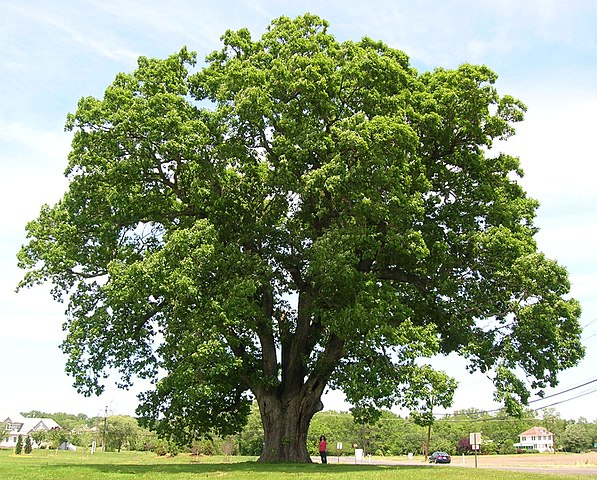All About Oak Trees In Johnston RI
Posted on 4/14/2020 11:33:35 PM

Oaks come in many sizes and shapes, and you'll even find a few evergreens in the mix as well. Whether you are looking for the perfect tree for your landscape or want to learn to identify the different types and species of oak trees than this article will certinly help you. Learn to identify a few of the more common oak species based on their bark, leaves, and other characteristics.
We love oak trees for several reasons, one being their inherent beauty, and another being the many uses of their wood for such things as fence posts, fence rails, barrels, casks, boards, and furniture are just a few. There is nothing quite like standing under a giant, ancient oak with a five-foot trunk diameter and gazing up into the treetop.
If you are trying to identify what kind of oak tree a leaf comes from, look at the lobes. If they are rounded, it's a white oak, and if they are pointed, it's a red oak. This will help you narrow down the potential number of oak trees by about half. Take into consideration the area where you found the leaf, as oak trees tend to be native to a certain area. You can use the number of lobes, the distance between the lobes, and the overall size of the leaves to help you narrow down your options further.
Indentifying An Oak Tree
An oak tree is one of the most common species of trees in the northern hemisphere which includes north america. Oak trees come in two major prototypes, red oak trees and white oak trees. Some oak trees have leaves that stay on the tree year-round (evergreen) and others have leaves that drop during dormancy (deciduous), plus they all bear the familiar acorn fruit.
The deciduous leaves are alternate, and 3-12 cm long and 2-6 cm broad. Its shape is variable. It is commonly shaped like a broad spatula, rounded at top and narrow and wedged at the base. The margins are smooth to shallowly lobed, with the apex and lobe tips ending in a bristle. Unlike other oak trees, the lobes look like drops of water dangling from the end of the leaves. With a dull green to bluish-green top and a paler bluish-green bottom, these leaves sport rusty-colored hair along its veins.
Fun Facts
Oak is part of the common name of about 400 species of trees and shrubs in the genus quercus, from the latin for "oak tree. " the genus is native to the northern hemisphere and includes deciduous and some evergreen species extending from cold latitudes to tropical asia and the americas. Oaks can be long-lived (hundreds of years) and large (70 to 100 feet high) and are excellent wildlife feeders because of their production of acorns.
Oak is the most common name for trees listed in the genus quercus. There are a few species that exhibit a shrub type growth form instead of a tree form. There are both deciduous and evergreen species and some are semi-evergreen. Currently there are approximately 400 different species listed in the quercus (oak) genus. The tree name "oak" is also used for the common names of some species in related genera, especially those listed in the lithocarpus genus.
White Oak Trees
The white oak is a large, strong, imposing specimen. It has a short stocky trunk with massive horizontial limbs. The wide spreading branches form an upright, broad-rounded crown. The bark is light ashy gray, scaly or shallow furrowed, variable in appearance, often broken into small, narrow, rectangular blocks and scales. The leaves are dark green to slightly blue-green in summer, brown and wine-red to orange-red in the fall. The fall foliage is showy. Oaks are wind pollinated. Acorns are produced generally when the trees are between 50-100 years old. Open-grown trees may produce acorns are early as 20 years.
Good acorn crops are irregular and occur only every 4-10 years. The white oak prefers full sun, but has a moderate tolerance to partial shade. It is more shade tolerant in youth, and less tolerant as the tree grows larger. It can adapt to a variety of soil textures, but prefers deep, moist, well-drained sites. High ph soil will cause chlorosis. Older trees are very sensitive to construction disturbances. The deep tap root can make transplanting difficult. This is why it is better to transplant when trees are young. New transplants should receive plenty of water and mulch beneath the canopy to eliminate grass competition.
Old oaks on upland sites can be troubled by sudden competition from and excessive irrigation of newly planted lawns. Their root zones must be respected for them to remain healthy. White oak is less susceptible to oak wilt than the red oak species.
Oak Trees in Johnston RI
Watch This Video About Oak Tree Identification in Johnston RI
This is a page on All About Oak Trees In Johnston RI
Search
Call Today For A FREE
Tree Service Quote!
401-226-0981
Categories
Recent Posts
-
!silo-posts